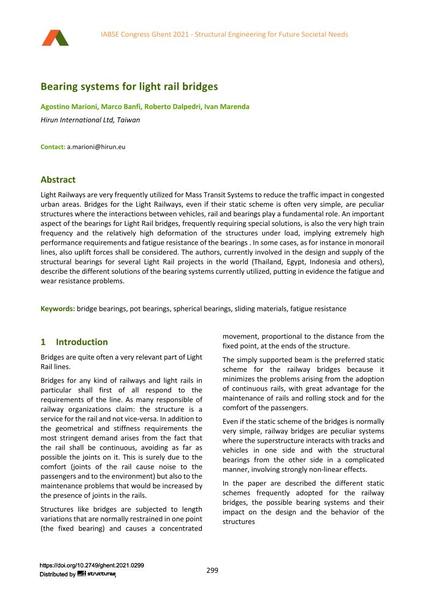Bearing systems for light rail bridges

|
|
|||||||||||
Détails bibliographiques
| Auteur(s): |
Agostino Marioni
(Hirun International Ltd, Taiwan)
Marco Banfi (Hirun International Ltd, Taiwan) Roberto Dalpedri (Hirun International Ltd, Taiwan) Ivan Marenda (Hirun International Ltd, Taiwan) |
||||
|---|---|---|---|---|---|
| Médium: | papier de conférence | ||||
| Langue(s): | anglais | ||||
| Conférence: | IABSE Congress: Structural Engineering for Future Societal Needs, Ghent, Belgium, 22-24 September 2021 | ||||
| Publié dans: | IABSE Congress Ghent 2021 | ||||
|
|||||
| Page(s): | 299-304 | ||||
| Nombre total de pages (du PDF): | 6 | ||||
| DOI: | 10.2749/ghent.2021.0299 | ||||
| Abstrait: |
Light Railways are very frequently utilized for Mass Transit Systems to reduce the traffic impact in congested urban areas. Bridges for the Light Railways, even if their static scheme is often very simple, are peculiar structures where the interactions between vehicles, rail and bearings play a fundamental role. An important aspect of the bearings for Light Rail bridges, frequently requiring special solutions, is also the very high train frequency and the relatively high deformation of the structures under load, implying extremely high performance requirements and fatigue resistance of the bearings . In some cases, as for instance in monorail lines, also uplift forces shall be considered. The authors, currently involved in the design and supply of the structural bearings for several Light Rail projects in the world (Thailand, Egypt, Indonesia and others), describe the different solutions of the bearing systems currently utilized, putting in evidence the fatigue and wear resistance problems. |
||||
| Mots-clé: |
appuis sphérique appuis de ponts appuis à pot
|
||||
| Copyright: | © 2021 International Association for Bridge and Structural Engineering (IABSE) | ||||
| License: | Cette oeuvre ne peut être utilisée sans la permission de l'auteur ou détenteur des droits. |
||||
